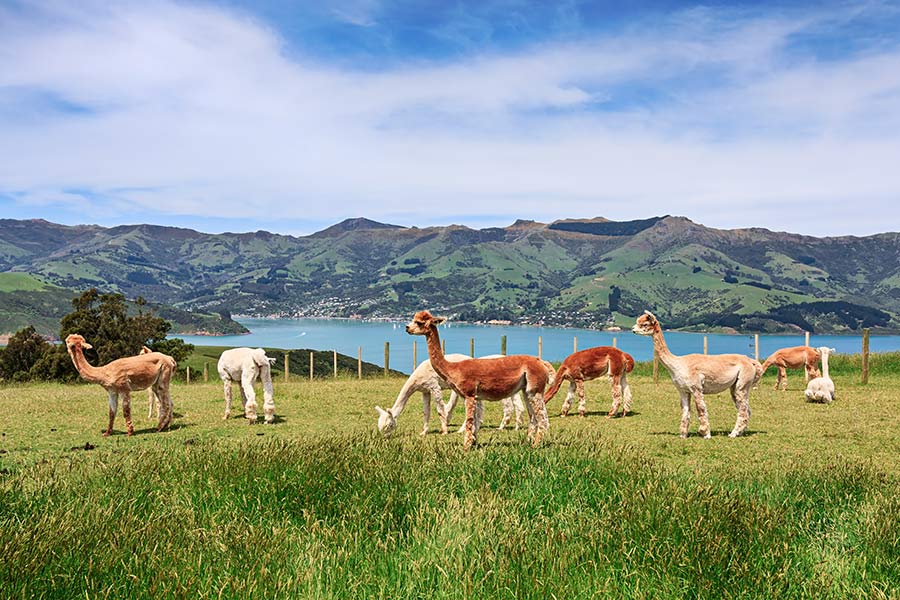Environmental Impact of Camelids

(Camelids herein defined as alpacas and llamas, but not including vicuna or guanaco)
We have been investigating the environmental impact of camelids for several years. These studies have included containment and shelter, feed intake, water intake, fecal output, fecal examination for important pathogens, and pasture management. These studies have allowed us to make a number of statements.
Containment and shelter:
Camelids are easily contained and rarely challenge fencing. These species do not perform activities that are destructive to fencing or wooden structures and rarely jump through, over, or under fences. The shelter must be provided for protection against adverse weather conditions. We have determined that alpacas require a minimum of 8 square feet per animal and llamas a minimum of 10 square feet per animal. Three-sided shelters with a roof are adequate for this requirement.
Feed and water intake and fecal output:
Camelids consume approximately similar amounts of water as compared with goats (approximately 1 to 1.5 gallons per head per day for alpacas; 2 to 3 gallons per head per day for llamas). Daily urine output of alpacas (average adult body weight 125 to 165 lbs.) and llamas (average adult body weight 250 to 350 lbs.) are similar to that of sheep (average adult body weight 150 to 300 lbs.) and goats (average adult body weight 125 to 200 lbs.). Thus, the biological equivalency to sheep is approximately 1.0. Camelids consume a relatively lower percentage of their body weight in dry matter on a daily basis as compared with sheep and goats. Sheep and goats are expected to consume approximately 2.5% of their body weight per day (e.g. 200 lbs. sheep consume 5 lbs. dry matter per day or 16.6 lbs. grass (assuming 30% dry matter of grass). Alpacas and llamas are expected to consume approximately 1.8 % of their body weight per day in dry matter (e.g. a 200 lbs. camelid would consume approximately 3.6 lbs. dry matter or 12 lbs. grass per day (assuming 30% dry matter of grass). Fecal output is proportional to dry matter intake. Thus, the biological equivalency to sheep is approximately 0.72. Based on these findings, we consider camelids to be a low risk for groundwater contamination (see further comments in pasture management).
Urine contamination:
Urine is a necessary by-product of life. Water is a vital nutrient for digestion and metabolic processes. Marcilese et al (1994) determined water turnover in llamas. In winter, body water was estimated as 659 ml/kg with a daily water turnover of 116 ml/ kg0.82. In spring and summer, daily water turnover was increased. Daily water turnover in lactating llamas in summer was approximately 396 ml/kg0.82 and that of non-lactating llamas was 260 ml/ kg0.82. In studies of water consumption, alpacas consumed similar water on a bodyweight basis as compared with goats. Rubsamen et al (1975) determined that llamas consumed 62 ml/kg0.82/24 hours and goats consumed 59 ml/kg0.82/24 hours. Thus, a 60 kg alpaca will consume less than 1 gallon (3.7 L) of water per day. Urine production is expected to approximate 10 to 15 ml/kg/24 hours. Thus, a 60 kg alpaca will produce approximately 1 quart (600 to 900 ml) of urine per day.
Pesticide use:
Pesticides are uncommonly used in alpacas because of the limited need to do so. Thus, the potential environmental impact is negligible.
Fecal pathogens:
Compared with traditional livestock species, camelids are not known to be carriers of important pathogens (e.g. Johne’s disease, Salmonella sp., E. coli OH:157, etc) and are uncommon carriers of secondary pathogens (e.g. Cryptosporidium sp., Giardia sp). In our studies involving random sampling of farms with alpacas and llamas, we have not found Salmonella sp or Johne’s Disease organisms. In a study performed by the University of California at Davis, they did not find E coli OH:157 or Cryptosporidium sp in camelid feces. Compared with traditional livestock species, we do not consider camelids to be a source of concern for potential pathogens to the human population.
Pasture management:
Camelids have a unique instinctual trait with respect to the deposition of feces and urine as compared with all traditional livestock. The camelids form “dung piles” in pastures. These dung piles are the animal kingdom equivalent of “community toilets”. Thus, these animals are extremely hygienic as compared with horses, cattle, sheep, and goats. These dung piles allow pastures to be cleaned effectively and efficiently on a regular basis. This is rarely done in other livestock because of the necessity to clean the entire pasture, not selected areas. In our research, dung piles will consume approximately 10 % of the pasture if kept cleaned on a regular basis. Without cleaning, pasture consumption increases to approximately 20%. Thus, the pasture contamination equivalency of camelids as compared with other livestock is approximately 0.1 to 0.2. Cleaning of dung piles with composting of manure allows for further limitation of any risk of groundwater contamination.
Summary Statement:
Based on our research to date, we consider camelids to be one of the lowest risk species in North American agriculture with respect to potential human exposure to pathogens or to by-products of the animals’ waste. This species seems ideally suited to “urban farm” settings.
David E Anderson, DVM, MS, Diplomate ACVS
Like this article? Become a RMLA Member today!

